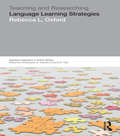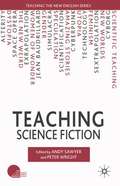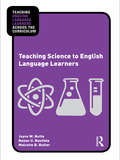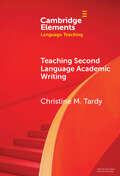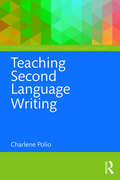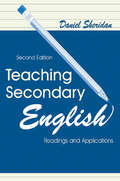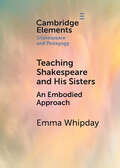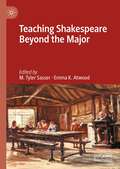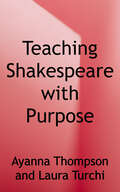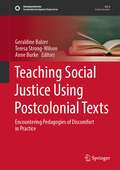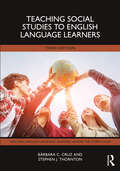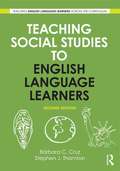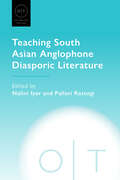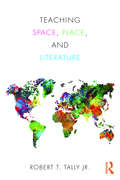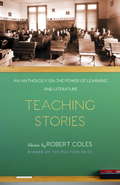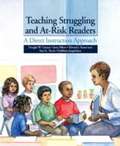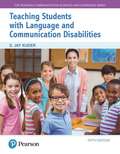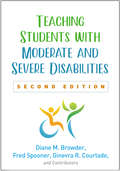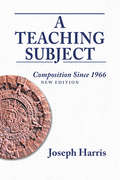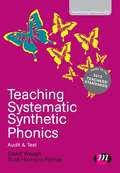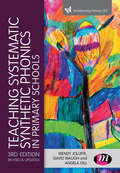- Table View
- List View
Teaching & Researching: Self-regulation In Context, Second Edition (Applied Linguistics in Action)
by Rebecca L. OxfordOver the past thirty years, the field of language learning strategies has generated a massive amount of interest and research in applied linguistics. Teaching and Researching Language Learning Strategies redraws the landscape of language learning strategies at just the right time. In this book Rebecca Oxford charts the field systematically and coherently for the benefit of language learning practitioners, students, and researchers. Offering practical, innovative suggestions for assessing, teaching, and researching language learning strategies, she provides examples of strategies and tactics from all levels, from beginners to distinguished-level learners, as well as a new taxonomy of strategies for language learning. In demonstrating why self-regulated learning strategies are necessary for language proficiency, Oxford integrates socio-cultural, cognitive, and affective dimensions, and argues convincingly for the need for conceptual cross-fertilization. Providing clear and concise explanations of the advantages and limitations of the different approaches, this book is full of practical value and theoretical insights. The book is designed to guide the reader with the use of a range of features, including: key quotes and concept boxes preview questions and chapter overviews glossary and end-of-chapter further readings sources and resources section
Teaching Science Fiction
by Andy Sawyer Peter WrightTeaching Science Fiction is the first text in thirty years to explore the pedagogic potential of that most intellectually stimulating and provocative form of popular literature: science fiction. Innovative and academically lively, it offers valuable insights into how SF can be taught historically, culturally and practically at university level.
Teaching Science to English Language Learners
by Joyce Nutta Nazan U. Bautista Malcolm B. ButlerBooks in the Teaching English Language Learners (ELLs) across the Curriculum Series are written specifically for pre- and in- service teachers who may not have been trained in ELL techniques, but still find themselves facing the realities and challenges of today's diverse classrooms and learners. Each book provides simple and straightforward advice on how to teach ELLs through a given subject area, and how to teach content to ELLs who are at different levels of English language proficiency than the rest of their class. Authored by both language and content area specialists, each volume arms readers with practical, teacher-friendly strategies, and subject-specific techniques. Teaching Science to English Language Learners offers science teachers and teacher educators a straightforward approach for engaging ELLs learning science, offering examples of easy ways to adapt existing lesson plans to be more inclusive. The practical, teacher-friendly strategies and techniques included here are proven effective with ELLs, and many are also effective with all students. The book provides context-specific strategies for the full range of the secondary sciences curriculum, including physical science, life science, earth and space science, science as inquiry, and history and nature of science and more. A fully annotated list of web and print resources completes the book, making this a one volume reference to help science teachers meet the challenges of including all learners in effective instruction. Special features: practical examples of science exercises make applying theory to practice simple when teaching science to ELLs an overview of the National Science Education Standards offers useful guidelines for effective instructional and assessment practices for ELLs in secondary grades graphs, tables, and illustrations provide additional access points to the text in clear, meaningful ways.
Teaching Second Language Academic Writing (Elements in Language Teaching)
by Christine M. TardyThis Element offers readers an overview of the theory, research, and practice of teaching academic writing to second language/multilingual (L2) students. The Element begins with a discussion of contextual features and some of the most common settings in which L2AW is taught. The Element then defines and shares examples of several concepts, pedagogical approaches, and teaching practices that are particularly relevant to L2AW instruction. Reflective questions guide readers to consider how these aspects of L2AW might be carried out within their own educational settings. Finally, the Element considers the rapid changes in technology and their influences on texts and academic writing.
Teaching Second Language Writing (The Routledge E-Modules on Contemporary Language Teaching)
by Charlene PolioThis module explores the purposes of and methods for teaching second language writing. Engaging and accessible, Teaching Second Language Writing is organized into three sections that mainly focus on activities, approaches and real-life writing tasks and genres that are the most applicable and useful for the language teaching classroom. -- The Routledge E-Book Modules on Contemporary Language Teaching introduce students to the major areas of second language instruction through jargon-free style and explain concepts as they are introduced thus facilitating comprehension for those with little or no background. The series consists of independent modules that can stand alone or be combined at the discretion of the reader or instructor. The modules can also be used as supplements to existing materials for maximum flexibility. Modules in this series include: Language (Bill VanPatten) Communication and Skill (Bill VanPatten) Second Language Acquisition: The Basics (Gregory D. Keating) Focusing on Form in Language Instruction (Wynne Wong and Daphnée Simard) Vocabulary in Language Teaching (Joe Barcroft) Interactive Tasks (Michael J. Leeser and Justin P. White) Technology in Language Learning: An Overview (Bryan Smith) Teaching Second Language Writing (Charlene Polio) Readers have the option to select and download electronically the 40-50 page modules for individual use, or to purchase multiple modules at once. With each module written by an expert in that respective field, with self-quizzes, reflection boxes, recommended readings, and discussion questions, these modules serve as the ideal text for introductory courses in Second Language Instruction. To purchase these modules and view module summaries, please visit the series companion website: www.routledgetextbooks.com/textbooks/9781315679594/
Teaching Secondary English: Readings and Applications
by Daniel SheridanThis new edition of Teaching Secondary English is thoroughly revised, but its purpose has not changed. Like the popular first edition, it balances content knowledge with methodology, theory with practice, and problem-posing with suggested solutions. The tone and format are inviting, while addressing student-readers on a professional level. Rather than attempting to cover everything, the text provides a framework and materials for teaching a secondary English methods course, while allowing considerable choice for the instructor. The focus is on teaching literature, writing, and language--the basics of the profession. Attention is given to the issues that arise as one seeks to explore what it means to "teach English." The problems and tensions of becoming a teacher are discussed frankly, in a manner that helps students figure out their own attitudes and solutions. Features: * Focuses on a few central concepts in the teaching of secondary English * Provides an anthology of 22 readable and challenging essays on key topics--allowing students to hear a variety of voices and opinions * Includes an applications section for each reading that extends the discussion and asks students to explore problems and grapple with important issues related to the articles * Offers short writing assignments in questions that follow the readings and in brief writing tasks in the applications, and a longer writing assignment at the end of each chapter * Addresses student readers directly without talking down to them New in the Second Edition: * This edition is shorter, tighter, and easier to use. * The opening and concluding chapters more directly address the concerns of new teachers. * The anthology is substantially updated (of the 22 articles included, 14 are new to this edition). * Each essay is preceded by a brief introduction and followed by questions for further thought. * There are fewer applications, but these are more extensive and more fully integrated within the text. * A writing assignment is provided at the end of each chapter. * Interviews with college students--before and after student teaching--are included in Chapters 1 and 6. * The bibliographies at the end of each chapter are fully updated.
Teaching Shakespeare and His Sisters: An Embodied Approach (Elements in Shakespeare and Pedagogy)
by Emma WhipdayWhat are we teaching, when we teach Shakespeare? Today, the Shakespeare classroom is often also a rehearsal room; we teach Shakespeare plays as both literary texts and cues for theatrical performance. This Element explores the possibilities of an 'embodied' pedagogical approach as a tool to inform literary analysis. The first section offers an overview of the embodied approach, and how it might be applied to Shakespeare plays in a playhouse context. The second applies this framework to the play-making, performance, and story-telling of early modern women – 'Shakespeare's sisters' – as a form of feminist historical recovery. The third suggests how an embodied pedagogy might be possible digitally, in relation to online teaching. In so doing, this Element makes the case for an embodied pedagogy for teaching Shakespeare.
Teaching Shakespeare Beyond the Centre
by Kate Flaherty Penny Gay L. E. SemlerShowcasing a wide array of recent, innovative and original research into Shakespeare and learning in Australasia and beyond, this volume argues the value of the 'local' and provides transferable and adaptable models of educational theory and practice.
Teaching Shakespeare Beyond the Major
by M. Tyler Sasser Emma K. AtwoodThis edited collection considers the task of teaching Shakespeare in general education college courses, a task which is often considered obligatory, perfunctory, and ancillary to a professor’s primary goals of research and upper-level teaching. The contributors apply a variety of pedagogical strategies for teaching general education students who are often freshmen or sophomores, non-majors, and/or non-traditional students. Offering instructors practical classroom approaches to Shakespeare’s language, performance, and critical theory, the essays in this collection explicitly address the unique pedagogical situations of today’s general education college classroom.
Teaching Shakespeare With Purpose: A Student-centred Approach
by Ayanna Thompson Laura TurchiWhat does it mean to teach Shakespeare with purpose? It means freeing teachers from the notion that teaching Shakespeare means teaching everything, or teaching "Western Civilisation" and universal themes. Instead, this invigorating new book equips teachers to enable student-centred discovery of these complex texts. Because Shakespeare's plays are excellent vehicles for many topics --history, socio-cultural norms and mores, vocabulary, rhetoric, literary tropes and terminology, performance history, performance strategies -- it is tempting to teach his plays as though they are good for teaching everything. <p><p>This lens-free approach, however, often centres the classroom on the teacher as the expert and renders Shakespeare's plays as fixed, determined, and dead. Teaching Shakespeare with Purpose shows teachers how to approach Shakespeare's works as vehicles for collaborative exploration, to develop intentional frames for discovery, and to release the texts from over-determined interpretations. In other words, this book presents how to teach Shakespeare's plays as living, breathing, and evolving texts.
Teaching Social Justice Using Postcolonial Texts: Encountering Pedagogies of Discomfort in Practice (Sustainable Development Goals Series)
by Teresa Strong-Wilson Geraldine Balzer Anne BurkeThis book explores how teachers can re-examine their emotional investments in enacting dominant settler values through changing their text selection and teaching practices. Based on a longitudinal qualitative research study conducted by a national team of literacy scholars in collaboration with practicing literacy teachers at eight sites across Canada, the book investigates how groups of teachers, working collaboratively in inquiry groups, develop and implement curriculum to promote their own and their students’ understandings of social justice in postcolonial and settler spaces. In particular, the book highlights the rich and dynamic landscape of postcolonial authors, illustrators and texts, the development of culturally- sensitive curricula, and critical pedagogies possible in addressing contemporary and historical issues, both local and global. This book is primarily of interest to literacy scholars, literacy instructors (teacher educators) in teacher education programs, educational leaders, practicing teachers from the K-12 spectrum, and school district staff and policy makers with responsibilities for or interests in the potential of literacy and literature engagement for social justice education. The book is also be of interest to postsecondary educators and teacher educators wishing to use literature in social justice, anti-racist, and anti-oppressive courses.
Teaching Social Studies to English Language Learners (Teaching English Language Learners across the Curriculum)
by Bárbara C. Cruz Stephen J. ThorntonThis fully updated new edition provides readers with a comprehensive understanding of the challenges that English language learners (ELLs), also known as English Learners (ELs), face, as well as the ways in which educators might address them in the social studies classroom.The authors offer context-specific strategies for the full range of the social studies curriculum, including geography, U.S. history, world history, economics, and government. These practical instructional strategies will effectively engage learners and can be incorporated as a regular part of instruction in any classroom. Features of this fully updated new edition include:· An updated and streamlined introduction, which provides an essential overview of ELL theory in a social studies-specific context;· "Teaching Tips" that offer helpful suggestions and ideas for creating and modifying lesson plans to be inclusive of English Learners;· Practical examples and pedagogical elements in Part 3, which include more visuals, suggestions for harnessing new technologies, discussion questions, and reflection points; and· Useful lists of online and print resources for teachers and students.Teaching Social Studies to English Language Learners is a valuable reference to help pre- and in-service social studies educators meet the challenges of including all learners in effective instruction.
Teaching Social Studies to English Language Learners
by Stephen J. Thornton Bárbara C. CruzTeaching Social Studies to English Language Learners provides readers with a comprehensive understanding of both the challenges that face English language learners (ELLs) and ways in which educators might address them in the social studies classroom. The authors offer context-specific strategies for the full range of the social studies curriculum, including geography, U.S. history, world history, economics, and government. These practical instructional strategies will effectively engage learners and can be incorporated as a regular part of instruction in any classroom. An annotated list of web and print resources completes the volume, making this a valuable reference to help social studies teachers meet the challenges of including all learners in effective instruction. Features and updates to this new edition include: • An updated and streamlined Part 1 provides an essential overview of ELL theory in a social studies specific-context. • "Teaching Tips" offer helpful suggestions and ideas for creating and modifying lesson plans to be inclusive of ELLs. • Additional practical examples and new pedagogical elements in Part 3 include more visuals, suggestions for harnessing new technologies, discussion questions, and reflection points. • New material that takes into account the demands of the Common Core State Standards, as well as updates to the web and print resources in Part 4.
Teaching South Asian Anglophone Diasporic Literature (Options for Teaching)
by Nalini Iyer and Pallavi RastogiMigration from the Indian subcontinent began on a large scale over 150 years ago, and today there are diasporic communities around the world. The identities of South Asians in the diaspora are informed by roots in the subcontinent and the complex experiences of race, religion, nation, class, caste, gender, sexuality, language, trauma, and geography. The literature that arises from these roots and experiences is diverse, powerful, and urgent.Teaching South Asian Anglophone Diasporic Literature embraces an intersectionality that attends to the historical and material conditions of cultural production, the institutional contexts of pedagogy, and the subject positions of teachers and students. Encouraging a deep engagement with works whose personal, political, and cultural insights are specific to South Asian diasporic consciousness, the volume also provokes meaningful reflection on other literatures in an age of increasing migration and diaspora.
Teaching Space, Place, and Literature
by Robert T. Tally Jr.Space, place and mapping have become key concepts in literary and cultural studies. The transformational effects of postcolonialism, globalization, and the rise of ever more advanced information technologies helped to push space and spatiality into the foreground, as traditional spatial or geographic limits are erased or redrawn. Teaching Space, Place and Literature surveys a broad expanse of literary critical, theoretical, historical territories, as it presents both an introduction to teaching spatial literary studies and an essential guide to scholarly research. Divided into sections on key concepts and issues; teaching strategies; urban spaces; place, race and gender and spatiality, periods and genres, this comprehensive book is the ideal way to approach the teaching of space and place in the humanities classroom.
Teaching Stories
by Robert ColesThe Call of Stories presents a study of how listening to stories promotes learning and self-discovery. Copyright © Libri GmbH. All rights reserved.
Teaching Storytelling in Classrooms and Communities: Amplifying Student Voices and Inspiring Social Change (Equity and Social Justice in Education Series)
by Maru Gonzalez Michael Kokozos Christy M. ByrdUnleash the transformative power of storytelling to build belonging, ignite critical consciousness, and amplify students’ voices. This dynamic book equips educators who work with middle and high school aged youth to teach storytelling in their classrooms or community organizations.Through inspiring examples and hands-on teaching strategies, the authors show you how to build trust and foster community, explore diverse storytelling modes and formats, guide students in developing effective and ethical social impact stories, and more. You’ll also discover practical tools to help students broaden their story’s reach and impact through collaboration and coalition building. Each chapter brims with student examples, ready-to-use teaching tips, and experiential activities, plus questions designed to spark dialogue and help students awaken and embrace the storyteller within. There are also reflective prompts to support your own journey as both a facilitator and participant in the storytelling exchange.Packed with practical resources, moving narratives, and actionable tips, this book is your essential guide to cultivating a supportive learning community, increasing student engagement, and unlocking young people’s leadership potential through the vehicle of storytelling.
Teaching Struggling and At-Risk Readers: A Direct Instruction Approach
by Douglas W. Carnine Jerry Silbert Edward J. Kame'Enui Sara G. Tarver Kathleen JongjohannTeaching Struggling and At-Risk Readers: A Direct Instruction Approach is designed to provide specific information to assist educators in being effective teachers of reading with all of their students. This three-part book provides information on incorporating instructional design and delivery principles into daily instruction for students at the beginning and primary stages of reading. It discusses: Structuring initial teaching procedures so teaching presentations are clear and foster a high degree of interaction between teachers and students. Using language and demonstration techniques that can be understood by all students. Sequencing the instruction of reading content to ensure essential skills and knowledge are taught in an aligned and coherent manner. Using techniques that provide adequate practice and review for students in developing high levels of fluency and accuracy.
Teaching Students With Language And Communication Disabilities
by S. KuderDesigned for special education teachers, this text contains numerous case studies illustrating the impact of language disorders on students and on classrooms. The book includes descriptions of language disabilities by category of disability, and contains activities for group or individual projects.
Teaching Students with Moderate and Severe Disabilities, Second Edition
by Diane M. Browder Fred Spooner Ginevra R. Courtade and ContributorsFor years the text of choice for developing excellence as a teacher of K–12 students with moderate and severe disabilities, this clearly written work has now been revised and updated. Chapters provide step-by-step procedures for designing standards-based individualized education plans and evaluating and enhancing student progress. Methods and materials for teaching literacy, mathematics, science, and social studies are described in depth. The book also describes effective ways to build functional daily living skills. User-friendly features include extensive vignettes and classroom examples, end-of-chapter application exercises, and reproducible planning and assessment tools. Purchasers get access to a Web page where they can download and print the reproducible materials in a convenient 8 1/2" x 11" size. New to This Edition *Reflects important advances in research and evidence-based practice. *Chapter on collaborating with culturally diverse families, plus a stronger multicultural focus throughout. *Chapter on writing instruction. *Two additional chapters on reading and math, ensuring coverage of both foundational and grade-aligned skills. *Increased attention to students with autism spectrum disorder and to uses of technology.
Teaching Subject, A: Composition Since 1966, New Edition (G - Reference,information And Interdisciplinary Subjects Ser.)
by Joseph HarrisIn this classic text, Joseph Harris traces the evolution of college writing instruction since the Dartmouth Seminar of 1966. A Teaching Subject offers a brilliant interpretive history of the first decades during which writing studies came to be imagined as a discipline separable from its partners in English studies. Postscripts to each chapter in this new edition bring the history of composition up to the present. Reviewing the development of the field through five key ideas, Harris unfolds a set of issues and tensions that continue to shape the teaching of writing today. Ultimately, he builds a case, now deeply influential in its own right, that composition defines itself through its interest and investment in the literacy work that students and teachers do together. Unique among English studies fields, composition is, Harris contends, a teaching subject.
Teaching Systematic Synthetic Phonics: Audit and Test (Transforming Primary QTS Series)
by David Waugh Ruth Harrison-PalmerCan you demonstrate a clear understanding of systematic synthetic phonics? If you are training to be a primary school teacher you need to have, and to demonstrate, a clear understanding of systematic synthetic phonics to meet the Teachers' Standards. This companion text to the popular Teaching Systematic Synthetic Phonics in Primary Schools enables you to audit your knowledge, making you more aware of the subject and the areas in which you need to know more. In all chapters, self audits are accompanied by guidance on next steps for developing your knowledge. All chapters feature sections that link your learning to the classroom, showing you how to use your knowledge to teach phonics. Designed to help build your confidence and develop your knowledge of phonics, this text supports your development as an effective teacher of reading. This is a companion text to: Teaching Systematic Synthetic Phonics in Primary Schools Joliffe, Waugh and Carss David Waugh is Director on Primary PGCE at Durham University where he is also the subject leader for English. He has published extensively in Primary English. David is a former deputy head teacher, was Head of the Education department at University of Hull, and was Regional Adviser for ITT for the National Strategies from 2008 to 2010. Ruth Harrison-Palmer is a former acting head teacher. She has worked for the National Strategies and Cumbria Local Authority as a literacy consultant. Currently Ruth has a senior role in ITE at the University of Cumbria.
Teaching Systematic Synthetic Phonics in Primary Schools (Transforming Primary QTS Series)
by Angela Gill David Waugh Wendy JolliffeThe government prioritizes systematic synthetic phonics as a key strategy in the teaching of reading and this is your guide to teaching systematic synthetic phonics in primary schools. This text supports trainee teachers working towards primary QTS through the exploration of a range of aspects of phonics teaching. It gives a balance of research and practice and allows trainees to develop and in-depth understanding of what works in phonics teaching, and why. It begins with the subject knowledge that underpins effective teaching - key aspects of the alphabetic code from discriminating sounds and phonemes to teaching long vowel phonemes and their different spellings and pronunciations. It goes on to explore pedagogy from the early years to Key Stage 2 giving guidance on, among others, systematic progression, intervention and multi-sensory and interactive methods. The title includes a review of different popular phonics programmes, set against the DfE (2011) criteria for high-quality phonics teaching. This third edition has been updated in line with changes in primary education. A new section includes classroom case studies and lesson ideas for teachers to learn about best practice from other teachers.
Teaching Systematic Synthetic Phonics in Primary Schools (Transforming Primary QTS Series)
by Angela Gill David Waugh Wendy JolliffeThe government prioritizes systematic synthetic phonics as a key strategy in the teaching of reading and this is your guide to teaching systematic synthetic phonics in primary schools. This text supports trainee teachers working towards primary QTS through the exploration of a range of aspects of phonics teaching. It gives a balance of research and practice and allows trainees to develop and in-depth understanding of what works in phonics teaching, and why. It begins with the subject knowledge that underpins effective teaching - key aspects of the alphabetic code from discriminating sounds and phonemes to teaching long vowel phonemes and their different spellings and pronunciations. It goes on to explore pedagogy from the early years to Key Stage 2 giving guidance on, among others, systematic progression, intervention and multi-sensory and interactive methods. The title includes a review of different popular phonics programmes, set against the DfE (2011) criteria for high-quality phonics teaching. This third edition has been updated in line with changes in primary education. A new section includes classroom case studies and lesson ideas for teachers to learn about best practice from other teachers.
Teaching Systematic Synthetic Phonics in Primary Schools (Transforming Primary QTS Series)
by David Waugh Angela Carss Wendy JolliffeThe government prioritizes systematic synthetic phonics as a key strategy in the teaching of reading and this text supports trainee teachers working towards primary QTS in how to use phonics effectively. The text begins by examining the central role of phonics in the teaching of reading, drawing on recent research and initiatives. It goes on to cover the essential knowledge trainees need to acquire themselves for the teaching of phonics to children. Accessible and relevant, the text uses case studies and useful research to support trainees in becoming competent and confident in the teaching of phonics. Supplement this text with the companion audit and test book: Teaching Systematic Synthetic Phonics Audit and Test About the Transforming Primary QTS series This series reflects the new creative way schools are begining to teach, taking a fresh approach to supporting trainees as they work towards primary QTS. Titles provide fully up to date resources focused on teaching a more integrated and inclusive curriculum, and texts draw out meaningful and explicit cross curricular links.
